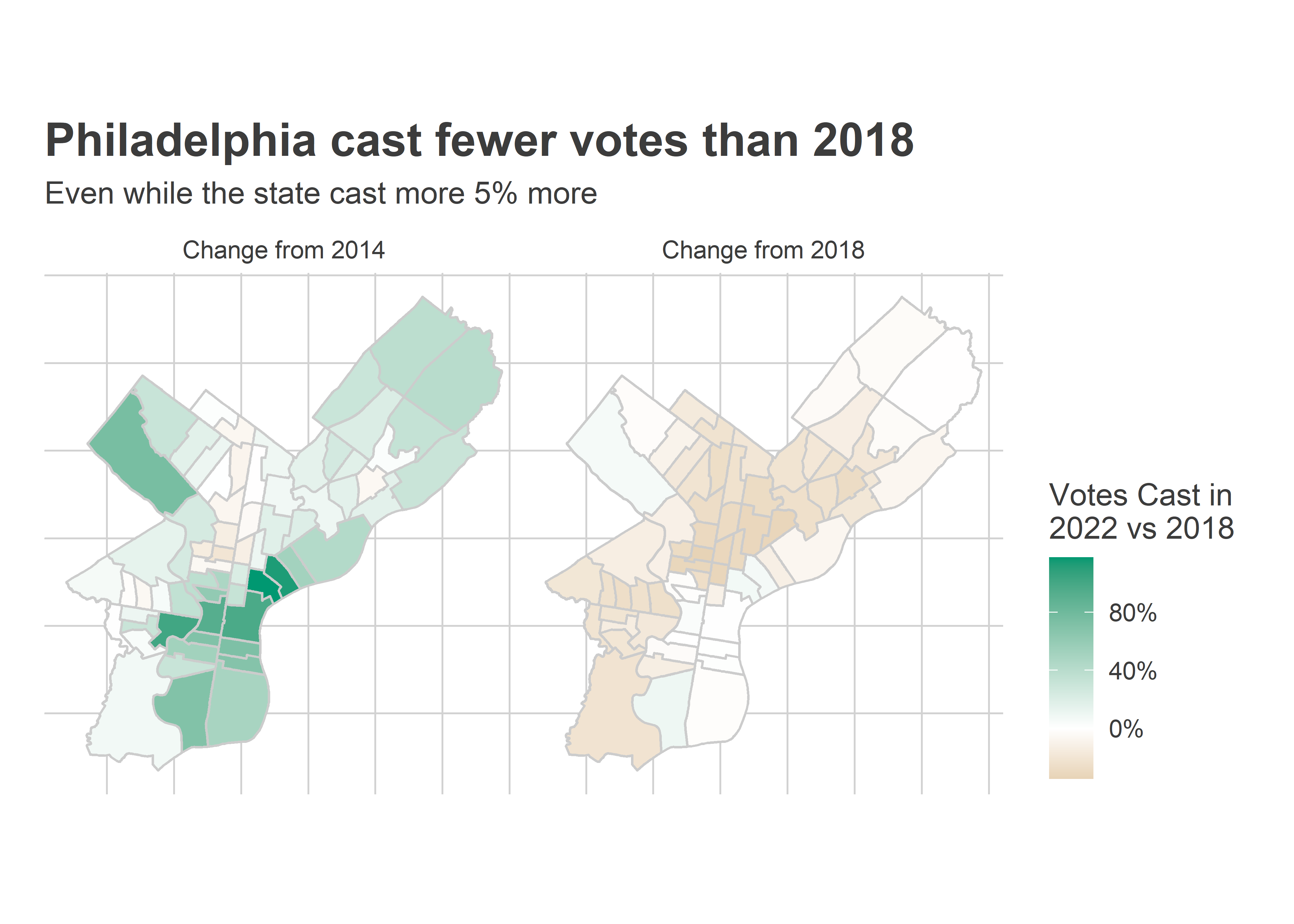
(Chart: Lara Putnam)
Pennsylvania Democratic voters turned out in surprising numbers for a midterm election last week, as we recapped in our last article, but the situation in Philadelphia was a lot more mixed.
Jonathan Tannen at the Sixty-Six Wards blog published a preliminary review of the turnout situation in Philadelphia, noting that while Pennsylvania as a whole turned out at a higher rate than in 2018, Philadelphia’s turnout fell short of matching 2018, though it was higher than in 2014.
To put that into perspective, if Philadelphia's share of statewide turnout had been 11.4% lower in 2020, like it was in 2022, Joe Biden would have lost Pennsylvania in the Presidential election.
 The available data is still incomplete, but the remaining votes won’t be enough to change the overall story significantly. According to Tannen,
The available data is still incomplete, but the remaining votes won’t be enough to change the overall story significantly. According to Tannen,
Philadelphia’s 485,000 votes cast for Senate were less than the astronomical 554,000 cast in 2018, but more than the 379,000 cast for Governor in 2014. The state as a whole cast more votes than 2018 though, (5.3M vs 5.0M) meaning that Philadelphia cast its lowest share of the state’s votes since at least 2002 (when I have data) [...]
The Wealthy Progressive parts of Center City and the Northwest managed to keep pace with 2018, while North and West Philly fell off sharply, back to 2014 levels.
Tannen is using “Wealthy Progressive” to refer to specific groupings of precincts he’s used to analyze election results and turnout over time that tend to vote similarly to one another.
Another way of looking at the patterns is to observe the difference in turnout in Open vs. Closed wards. A data analyst friend of the site did a first-pass analysis of the available turnout data and found that the Open Wards—where the elected committee people have greater ability to participate in the business of running the ward, and perhaps more motivation as a result—performed quite a bit better on average than the Closed Wards.
Of the Top 20 performing Wards, based on the percentage change from 2018, 45% of them are self-proclaimed "Open Wards." The 4 worst-performing Open Wards either just recently became open (24, 51, 60) or have substantially higher populations of students (27). While overall Philly had around a -12% decline in turnout compared to 2018, the Open Wards only had a -4% decline on average, vs -15% for Closed Wards.
What’s more, some of the highest-performing wards in terms of overall turnout had some of the best results for Dr. Mehmet Oz. The top-performing Ward, as a percentage change compared to 2018, was the 26th Ward, which voted for Dr. Oz with 50.37% of the vote.
The 21st Ward (Roxborough/Manayunk) was the 4th top-performing ward in terms of turnout, but delivered 21.52% of their votes to Dr. Oz, and 17.7% of their votes to Doug Mastriano. City-wide, Dr. Oz received 16% of the vote, and Mastriano 13%. In the Northeast, the 66th Ward was the 7th top-performing Ward and went 49.58% to Oz, and the 57th and 58th wards ranked 11th and 12th in terms of turnout, and went 42.89% and 50.19% to Oz, respectively. So not only were turnout rates lower in wards with a higher share of Democratic base voters, they were also among the highest in wards with more conservative voters.
There were some bright spots for 21st Ward Democrats though too, despite the above-average share of Dr. Oz votes, as the Vote the Ridge website notes. Vote the Ridge, an independent political action committee working in the 21st Ward, reports working with 100 volunteers to deliver 4,400 postcards, canvassing 4,000 voters, distributing 450 yard and window signs, and holding 15 voter registration events.
VTR says these grassroots efforts helped produce an outcome in the 21st Ward where the statewide Democratic candidates received higher absolute numbers of votes than their 2018 counterparts, received a higher share of the vote than their 2018 counterparts, and won a larger proportion of votes than President Biden won in 2020.
There's not enough out there to go on to make many confident claims about the effectiveness of the party mobilization efforts in different places, but Democratic City Committee should still take the news about Philly's reduced share of statewide turnout as a call for more analysis and introspection ahead of 2024, and try to replicate some of the more localized party organizing success stories in more wards throughout the city.

Showing 2 reactions
Sign in with
Facebook